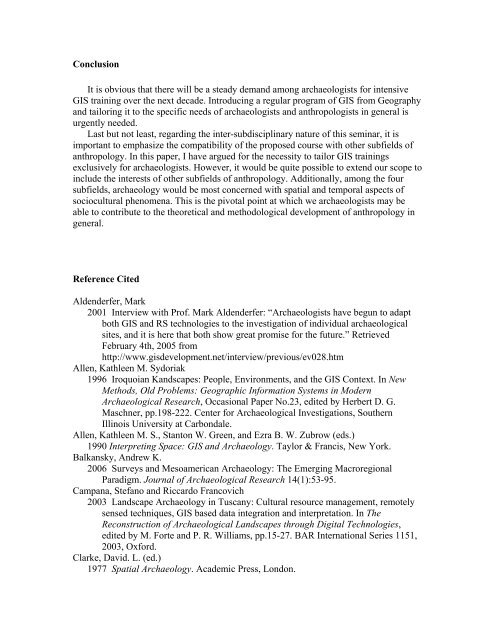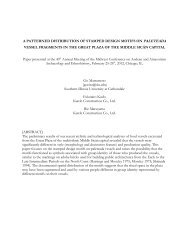GIS Trainings for Archaeologists
GIS Trainings for Archaeologists
GIS Trainings for Archaeologists
You also want an ePaper? Increase the reach of your titles
YUMPU automatically turns print PDFs into web optimized ePapers that Google loves.
Conclusion<br />
It is obvious that there will be a steady demand among archaeologists <strong>for</strong> intensive<br />
<strong>GIS</strong> training over the next decade. Introducing a regular program of <strong>GIS</strong> from Geography<br />
and tailoring it to the specific needs of archaeologists and anthropologists in general is<br />
urgently needed.<br />
Last but not least, regarding the inter-subdisciplinary nature of this seminar, it is<br />
important to emphasize the compatibility of the proposed course with other subfields of<br />
anthropology. In this paper, I have argued <strong>for</strong> the necessity to tailor <strong>GIS</strong> trainings<br />
exclusively <strong>for</strong> archaeologists. However, it would be quite possible to extend our scope to<br />
include the interests of other subfields of anthropology. Additionally, among the four<br />
subfields, archaeology would be most concerned with spatial and temporal aspects of<br />
sociocultural phenomena. This is the pivotal point at which we archaeologists may be<br />
able to contribute to the theoretical and methodological development of anthropology in<br />
general.<br />
Reference Cited<br />
Aldenderfer, Mark<br />
2001 Interview with Prof. Mark Aldenderfer: “<strong>Archaeologists</strong> have begun to adapt<br />
both <strong>GIS</strong> and RS technologies to the investigation of individual archaeological<br />
sites, and it is here that both show great promise <strong>for</strong> the future.” Retrieved<br />
February 4th, 2005 from<br />
http://www.gisdevelopment.net/interview/previous/ev028.htm<br />
Allen, Kathleen M. Sydoriak<br />
1996 Iroquoian Kandscapes: People, Environments, and the <strong>GIS</strong> Context. In New<br />
Methods, Old Problems: Geographic In<strong>for</strong>mation Systems in Modern<br />
Archaeological Research, Occasional Paper No.23, edited by Herbert D. G.<br />
Maschner, pp.198-222. Center <strong>for</strong> Archaeological Investigations, Southern<br />
Illinois University at Carbondale.<br />
Allen, Kathleen M. S., Stanton W. Green, and Ezra B. W. Zubrow (eds.)<br />
1990 Interpreting Space: <strong>GIS</strong> and Archaeology. Taylor & Francis, New York.<br />
Balkansky, Andrew K.<br />
2006 Surveys and Mesoamerican Archaeology: The Emerging Macroregional<br />
Paradigm. Journal of Archaeological Research 14(1):53-95.<br />
Campana, Stefano and Riccardo Francovich<br />
2003 Landscape Archaeology in Tuscany: Cultural resource management, remotely<br />
sensed techniques, <strong>GIS</strong> based data integration and interpretation. In The<br />
Reconstruction of Archaeological Landscapes through Digital Technologies,<br />
edited by M. Forte and P. R. Williams, pp.15-27. BAR International Series 1151,<br />
2003, Ox<strong>for</strong>d.<br />
Clarke, David. L. (ed.)<br />
1977 Spatial Archaeology. Academic Press, London.






